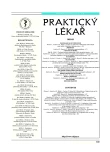Contribution of fine needle aspiration biopsy under control with ultrasound for a more precise determination of the etiology of ascites
Přínos cytologické aspirační punkce pod ultrazvukovou kontrolou pro upřesnění etiologie ascitu
Cílem práce je posouzení přínosu cytologického vyšetření ascitu nejasné etiologie k rozlišení mezi jeho benigní nebo maligní etiologií, v případě maligního ascitu dále jeho přínosu k bližšímu upřesnění zjištěné malignity. V období 1986–2003 autoři provedli u 151 osob s malým množstvím ascitu metodou cílené aspirační punkce tenkou jehlou pod kontrolou ultrazvuku diagnostický odběr ascitu k následnému cytologickému zpracování a zhodnocení. Z tohoto počtu osob se u 88 osob jednalo o ascites při nezhoubných onemocněních, u 63 osob o ascites při zhoubných onemocněních. Při základním cytologickém rozlišení dignity byl ve 2 případech nález falešně pozitivní a v 7 případech falešně negativní. Senzitivita, specificita a diagnostická přesnost při základním rozlišení etiologie ascitu byly vysoké, a to 89 %, 98 %, 94 %. Nižší přínos metodiky byl při upřesnění typu a primární lokalizace maligního nádoru provázeného ascitem. Správný cytologický závěr byl u 29 osob z 63, tzn. ve 46 % případů (senzitivita 46 %). V závěru autoři konstatují, že cytologické vyšetření ascitu nejasné etiologie je jedním ze základních diagnostických postupů k rozlišení mezi jeho benigní nebo maligní etiologií. V menší míře může přispět toto vyšetření i k bližšímu upřesnění typu maligního procesu a jeho primární lokalizace.
Klíčová slova:
ascites – aspirační cytologie tenkou jehlou (FNAB) – ultrazvuk.
Authors:
Arnošt Martínek 1
; J. Dvořáčková 2; P. Klvaňa 1; J. Horáček 3; V. Hrabovský 1
Authors‘ workplace:
Interní klinika Fakultní nemocnice s poliklinikou, Ostrava
přednosta doc. MUDr. A. Martínek, CSc.
1; CGB Laboratoř, Ostrava, vedoucí lékař MUDr. J. Dvořáčková
2; Ústav patologické anatomie, Zdravotně-sociální fakulta, Ostravská
univerzita, přednosta doc. MUDr. J. Horáček, CSc.
3
Published in:
Prakt. Lék. 2005; 85(8): 451-453
Category:
Diagnostis
Overview
The objective of the study is the assessment of the contribution of cytological investigation of ascites of obscure etiology to differentiate between benign and malignant etiology, and in the case of malignant ascites its contribution to a more detailed specification of its malignancy. Over the period 1986 through 2003 the authors performed, in 151 persons with a small amount of ascites, samplings of ascites by the method of targeted aspiration biopsy with a fine needle under control of ultrasound, for consequent cytological investigations and evaluation. Of that number, in 88 subjects in question was ascites in benign disease, in 63 subjects it was ascites in malignant disease. In basic cytological differentiation of malignancy there were 2 cases of false-positive findings and 7 cases were falsely negative. The sensitivity, specificity, and diagnostic precision in the basic differentiation of etiology of the ascites were high, namely 89%, 98%, and 94%, respectively. A lesser contribution of the method was in the specification of the type and primary localization of the malignant tumor connected with the ascites. A correct cytological conclusion was in 29 of 63 subjects, i.e. in 46% of cases (46% sensitivity). In conclusion, the authors state that cytological investigation in ascites of obscure etiology is one of the fundamental diagnostic procedures for differentiating between its benign and malignant etiology. To a lesser degree it can contribute even in closer specification of the type of malignant process and its primary localization.
Key words:
ascites – fine-needle aspiration biopsy (FNAB) – ultrasound.
Labels
General practitioner for children and adolescents General practitioner for adultsArticle was published in
General Practitioner

2005 Issue 8
- Metamizole vs. Tramadol in Postoperative Analgesia
- Memantine in Dementia Therapy – Current Findings and Possible Future Applications
- Metamizole at a Glance and in Practice – Effective Non-Opioid Analgesic for All Ages
- What Effect Can Be Expected from Limosilactobacillus reuteri in Mucositis and Peri-Implantitis?
- Hope Awakens with Early Diagnosis of Parkinson's Disease Based on Skin Odor
Most read in this issue
- Bacterial immunomodulators
- Diagnosis and therapy of tracheal stenosis
- Antibiotics and their application in pregnancy
- Contribution of fine needle aspiration biopsy under control with ultrasound for a more precise determination of the etiology of ascites
